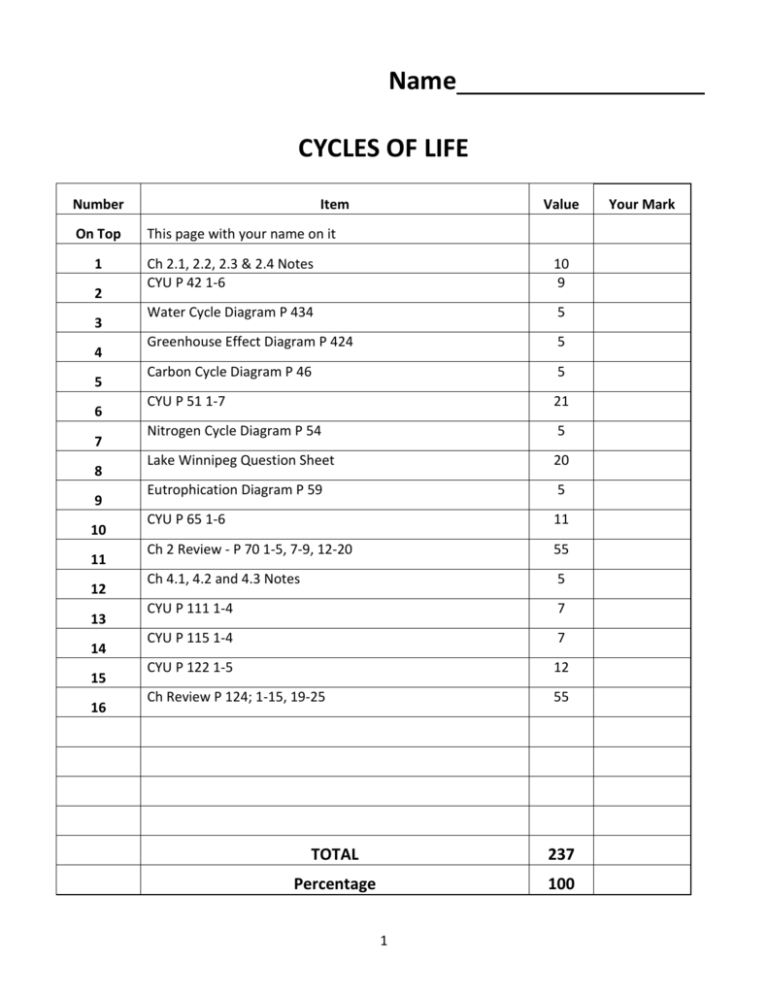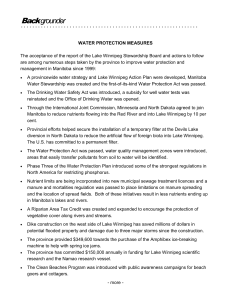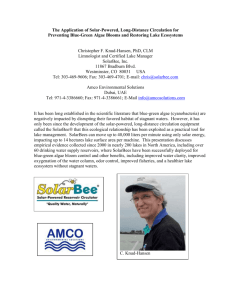2 notes-blanks
advertisement

Name CYCLES OF LIFE Number On Top 1 2 3 4 5 6 7 8 9 10 11 12 13 14 15 16 Item Value This page with your name on it Ch 2.1, 2.2, 2.3 & 2.4 Notes CYU P 42 1-6 10 9 Water Cycle Diagram P 434 5 Greenhouse Effect Diagram P 424 5 Carbon Cycle Diagram P 46 5 CYU P 51 1-7 21 Nitrogen Cycle Diagram P 54 5 Lake Winnipeg Question Sheet 20 Eutrophication Diagram P 59 5 CYU P 65 1-6 11 Ch 2 Review - P 70 1-5, 7-9, 12-20 55 Ch 4.1, 4.2 and 4.3 Notes 5 CYU P 111 1-4 7 CYU P 115 1-4 7 CYU P 122 1-5 12 Ch Review P 124; 1-15, 19-25 55 TOTAL 237 Percentage 100 1 Your Mark 2.1 A Matter of Life and Death Read P 40 & 42 and do 1-6 on P 42 2.2 Carbon Cycle Where does the mass of a tree come from? – Recall: Photosynthesis (in green plants). Light Energy 6CO2 + 6H2O - Carbon Dioxide comes from - Carbohydrates are made into - Animals - Carbon is returned - Decomposers return C6H12O6 + 6O2 and water comes from Cellular Respiration (ALL organisms) C6H12O6 + 6O2 6CO2 + 6H2O Energy - Carbon is returned to the atmosphere The Carboniferous Period - Carbon cycle - Much plant material - Carbon wasn’t - Carbon was trapped - Today all that carbon 2 Oceans and the Carbon Cycle - Water holds - CO2 dissolves - Carbonic acid - Cellular Respiration - Dead, decaying organisms (especially those with shells – and - Sedimentary rocks eventually Recall Greenhouse Effect. Draw Greenhouse Effect diagram below. (See text p 424) 3 ) sink Carbon Cycle Diagram (P 46 and ppt.) Assignment: P 51 1-5 4 2.3 The Nitrogen & Phosphorous Cycles - Nitrogen is - Nitrogen is Nitrogen Fixation - Plants can’t - Nitrogen must be “fixed” or - Fixation taxes place by on the roots of legumes – peas, beans, alfalfa, and clover. - Nitrogen enters - Dead organisms and wastes - In the ocean, blue-green algae - Dead organisms Nitrification - Decomposers turn the nitrogen into ammonia NH4. (also in pig & chicken manure) Nitrification: Ammonia Nitrifying Bacteria Nitrates Denitrification: Nitrates Denitrifying Bacteria Nitrogen gas Draw Diagram p 54 5 Humans Impacts on the Nitrogen/Phosphorous Cycle - We add - 140 million EXTRA tonnes of nitrogen - Nitrogen overload: o Nitrogen saturation – The extra Extra nitrogen Soil becomes Extra nitrogen in the air (fossil fuel pollution) About Liming (adding powdered limestone to lakes) Fertilizers and detergents and wastes Water Ocean & lakes Dead algae Decomposers Neighbouring food chains 6 Lake Winnipeg dying? By Carol Sanders Winnipeg Free Press (Friday, January 17, 2003) Scientists warn levels of damaging micro-organisms are soaring. Lake Winnipeg is starting to look more like Lake Erie of 30 years ago, which was then considered the slop pail of North America, scientists warn. "Everybody is contributing to the problem," Al Kristofferson, co-ordinator of the Lake Winnipeg Research Consortium, told the Red River Basin Summit yesterday. "Things have happened in the lake during the last 50 years that we have to pay attention to," said Kristofferson, who leads the University of Manitoba-based consortium, which is made up of 23 agencies. It spent 81 days on Lake Winnipeg last year checking the health of the so-called Prairie ocean. Algae blooms in the north basin of the lake are clogging commercial fisher's nets with "dirt" in the summer and in the south basin during the winter, he said. "Seeing is believing." Lake Erie gained notoriety as a "dead lake," killed by pollution, before controls were put in place with the U.S. Clean Water Act in 1972. A vast, deep section of Lake Erie was oxygen-starved in the summer because rotting algae on the bottom used up the oxygen. The top of the lake had excess nutrients -- mostly from sewage-treatment plants -- that fed algae, causing blooms that turned the lake green and putrid, chasing swimmers away from beaches. Lake Winnipeg Research Consortium's research team spent 81 days on the Manitoba lake this past spring, summer and fall. A comparison of samples taken in 1969, 1999 and this past summer, shows soaring levels of micro-organisms. Levels of plankton and phytoplankton have jumped dramatically, and foreign species like rainbow smelt have entered Lake Winnipeg from the Winnipeg River system, bringing with them contaminants like mercury, said Kristofferson. The crustacean E. coregoni, which was once found only in the Great Lakes, has made its way into the lake as well. It's another indicator of the arrival of foreign species in the lake, into which all the rivers and streams from the Rockies to North Dakota to just west of Lake Superior drain. Most of the water that flows into Lake Winnipeg comes from the Saskatchewan and Winnipeg rivers, but most of the nutrients killing the lake are carried into it via the Red River, said Kristofferson. Some of the nutrient-loading originates from south of the U.S. border. "We try to be a good neighbour," said Roger Hanson of the Sand Hill River Watershed District in northern Minnesota, who attended the summit to see how people south of the border can help. The U.S. Clean Water Act that helped clean up Lake Erie gave teeth to environmental regulations. The results included municipal and industrial sewage plant improvements that slowed the growth of algae. That allowed oxygen to return to the lake. 7 Farmers were encouraged to use less phosphorus-based fertilizer and more conservation tillage. Factories were forced to remove many of the chemicals from their sewage before it was discharged. Phosphorus, a primary cause of the algae blooms, was banned from laundry detergents in the Great Lakes states. Hanson said he thinks the solution for Lake Winnipeg lies not with tougher legislation, but with making people aware of what impact they're having on the environment. "It's people-driven more than anything," said the Beltrami, Minn. resident. "You can have all the laws in the world, but you want people to want to do the right thing." Increased livestock production, agricultural runoff, municipal waste discharges and the use of the lake by Manitoba Hydro as a reservoir are contributing factors, but Kristofferson said it is too soon to point the finger of blame. "It's going to require a lot of research over many years," he said. Last year's expeditions were the first time the consortium was able to conduct a thorough examination of the whole lake. The research isn't cheap. The consortium has to raise $500,000 a year to fund it, Kristofferson said. The group uses a 31.5-metre former Canadian Coast Guard vessel, the Namao, as a research platform. The consortium's main contributor is Manitoba Hydro, which provides one-third of the funding. "Manitoba Hydro is a good corporate citizen and an example to others, whether they be municipalities or cities," said Kristofferson. The research is vital, especially with climate change expected to have such a major impact on the lake, he said. The consortium is careful not to take sides or make political statements, Kristofferson said. "We have to remain neutral or our credibility disappears," said Kristofferson. "We're not a lobby group." He said he couldn't answer a question from the floor at the summit about what impact the City of Winnipeg's sewage treatment system is having on Lake Winnipeg. Two of three city sewage plants discharge too much ammonia as well as nutrients that combine with farm runoff to cause toxic algae blooms on Lake Winnipeg, it has been previously reported. A $480million plan for fixing the problems will be reviewed by Manitoba's Clean Environment Commission starting Monday. Protecting the lake isn't just a noble pursuit -- it's a financially prudent investment, said Liberal leader Jon Gerrard, who attended the summit. The lake contributes $500 million to the Manitoba economy through recreation, tourism, commercial fishing and hydro production. "Clearly something very dramatic is happening." 8 Lake Winnipeg Dying? 1. Why is Lake Winnipeg being compared to Lake Erie? 2. What are algae blooms on the north basin causing? 3. What happened to Lake Erie in 1972? What caused this? 4. What levels have jumped drastically in recent years? 5. What foreign species have entered the lake? 6. Which rivers provide the greatest flow volume into Lake Winnipeg? 7. Which river carries the most lake killing nutrients? 8. What changes in farming practices can reduce these levels? 9. What is the solution for Lake Winnipeg? 10. What are the contributing factors to this problem? 11. What is the source of most of the ammonia and nutrients? 12. Why is the health of the lake so important? 13. What is the province planning to do about it? 9 Draw Eutrophication Diagram P 59 10 Biodiversity Definition o Necessary for o Areas of Earth o Bio diversity is reduced by: o Invasive Species (def’n) - o The species thrives because: o Examples of invasive species Assignment: P 65 1-6 2.4 Closing the Loop – Sustainability Read P 66-68 and Do P 68 1-4 Ch Review P 70 1-5, 7-9, 12-20 11 Ch 4 - Humans and Sustainability 4.1 Managing Resources – Tragedy of the Commons British pastures As a result: o o o What does this say about our ability to manage a “free” resource like nature that everyone shares? Our Views of nature Traditional Effects Example – Deer Population Read pages 104 – 111 Assignment pg 111 #1 – 4 (7 marks) 4.2 Ecological Footprints Cities are places where Geographic vs. ecological location Technology requires Technology produces Human-Technological impact Ecological Footprint Formula (p113) – (COMPUTER ACTIVITY) 12 Paradigm People in developed countries (Canada) consume and produce than people in developing countries. 4.3 Sustainable Future - Paradigm A way of looking at the world o 100 years ago – o Now – o Result – controls on o Natural resources Biotechnology/Bioengineering In the flood of ideas to fix the problems we have created, we have stumbled across yet another way to save the world from resource depletion by finding new ways to use the resources. We now engineer our own organisms to grow faster, bigger, stronger, with less food. Bioengineering literally means “designing life”. (See picture p 119) What are the risks to the environment? What are the possible gains? 13 Is technology enough? Technology has invented cars that run on half as much gas, what has the human response been? We can build houses with fewer supplies that require less energy, what has been the response? What sort of paradigm shift do you think would be needed to create a sustainable world? What about quality of life? What is the impact of importing resources? Let Them Eat Cake Activity Read P116 – 122 Do questions 1 –4, 6 on p 115 and 1 – 5 on P122 14







